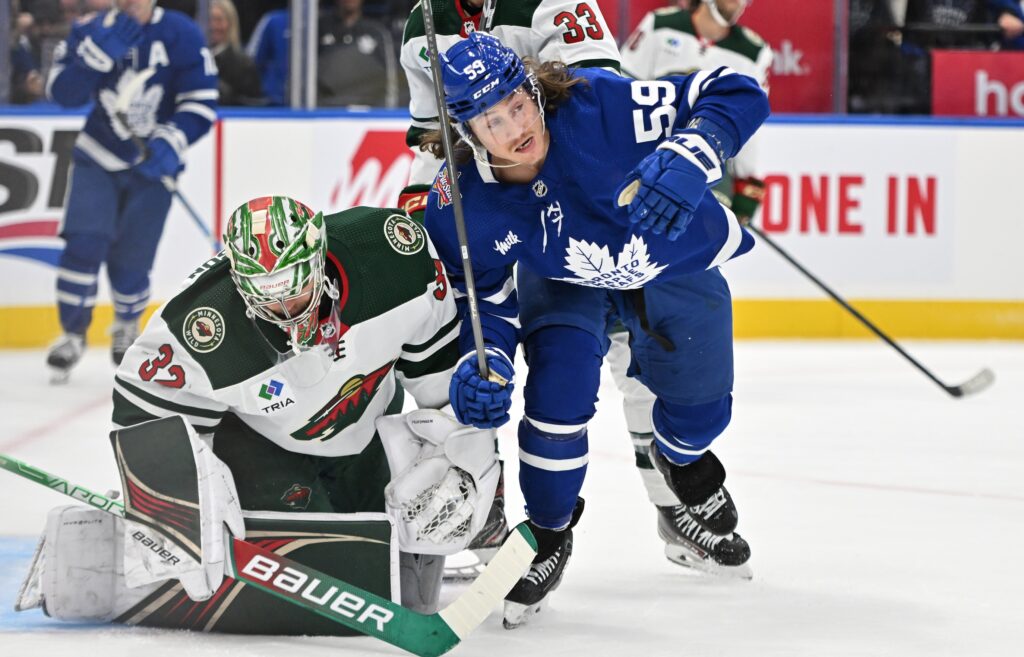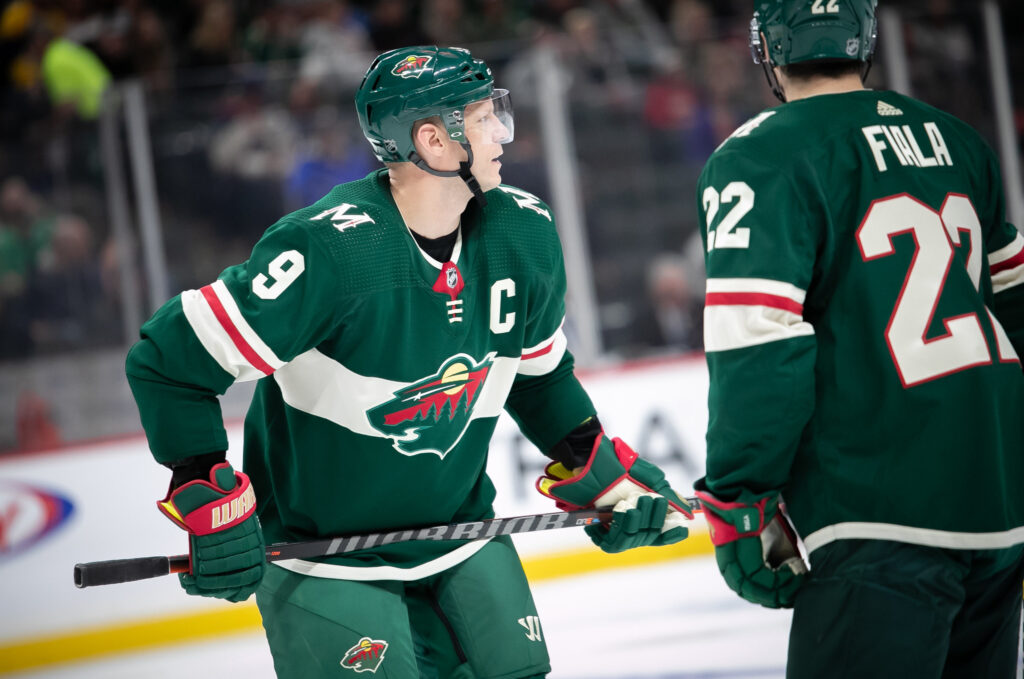For just the second time in the past 12 seasons (and third if you throw out the NHL’s qualifying round in 2020), the Minnesota Wild aren’t in the NHL Playoffs. But for Wild fans looking to get their playoff hockey fix, they needed to look no further than the Toronto Maple Leafs.
The Maple Leafs’ futility in the playoffs has been well-documented with one series win over the last 20 years, but there are several aspects that may have made Wild fans feel like they were staring into a mirror in their quarterfinal loss to the Boston Bruins.
1. A power-play dropoff
One of the biggest issues with Toronto this postseason was its performance on special teams. The Maple Leafs went 1 for 18 on the power play in their seven-game series with the Bruins, and it wasn’t a new occurrence.
Over the past three seasons, Toronto’s power play ranked third in the NHL by converting 25.7% of its opportunities in the regular season, but the Maple Leafs have gone 13 for 81 (16%) in the playoffs.
By comparison, Minnesota’s power play has converted on 21.6% of its chances, 11th the past three seasons, but it has just a 17.4% conversion rate in the playoffs. The Wild had a 22.7% conversion rate that ranked 10th in the NHL this season, but their playoff dropoff may have become a concern had they sneaked their way in.
2. A poor penalty kill
While the Leafs couldn’t score on the power play, the Bruins had no such issues in this series. Boston scored six goals with the extra attacker, and it was a key reason why the Bruins took a 3-1 series lead on Jake DeBrusk’s power-play goal in Game 3 and Brad Marchand’s power-play goal in Game 4.
The Maple Leafs cleaned things up in the final three games, but it didn’t cover for a team that ranked 23rd with a 76.8% kill rate this season. If you look further down the list, you’ll see the Wild ranking 30th at 74.52%.
These issues could be minimized if either team stayed out of the box, but Toronto ranked ninth in penalty minutes this season while the Wild ranked fourth.
Wild fans may also remember a tripping penalty on Marcus Foligno in Game 4 of last year’s playoff series against the Dallas Stars, which led to Tyler Seguin’s power-play goal in a 3-2 victory for Dallas in Game 4. In the following game, Foligno was given a game misconduct for kneeing, which led to another power-play goal for Seguin and a 4-0 victory for Dallas.
Both plays swung the momentum of the series and exposed a glaring problem for the Wild and the Leafs over the past several seasons.
3. A lack of depth
Injuries and poor performances played a key role in the Leafs’ loss to the Bruins and were also a reason why the Wild were watching the playoffs from home.
Toronto’s depth was aided by free agent acquisitions Tyler Bertuzzi and Max Domi, but it had issues in the bottom six after Ryan O’Reilly signed with the Nashville Predators in free agency. While the Leafs were able to ride it out in the regular season, David Kämpf’s goal in Game 1 was the only goal they got from their bottom six in the series.
Like the Maple Leafs, who boast Auston Matthews (69 G, 38 A, 107 P), William Nylander (40 G, 58 A, 98 P) and Mitch Marner (26 G, 59 A, 85 P), the Wild have a similar strength in the top six, led by Kirill Kaprizov (46 G, 50 A, 96 P), Matt Boldy (29 G, 40 A, 69 P) and Joel Eriksson Ek (30 G, 34 A, 64 P).
The problem has been getting the bottom six players to contribute. Ryan Hartman (21 G, 24 A, 45 P) enjoyed a solid season after being miscast as the team’s top center the past two seasons, but Foligno hasn’t been able to match his production, notching 43 points combined over the last two seasons after putting up 42 in the 2021-22 season.
Depth also became an issue down the stretch as Kaprizov scored 26 of the Wild’s 87 goals in the final 28 games of the regular season. With Kaprizov contributing just under 30% of the Wild’s offensive output, Minnesota needs to find a way to get more from its bottom six.
4. Struggles in net
The Leafs and Wild had the exact same save percentage at .893 this season, and the goaltending woes played a sizeable role in each team’s fate.
Toronto relied on Ilya Samsonov for a majority of this year’s playoffs, and he struggled throughout the year with a 3.13 goals-against average and .890 save percentage during the regular season. Samsonov also posted a .770 save percentage on high-danger chances but also had lapses, including a goal by Trent Frederic that tied Game 3.
But while Samsonov struggled, so did Filip Gustavsson, who ranked below the 50th percentile in overall save percentage (.899), midrange save percentage (.884), percentage of games above a .900 save percentage (41.9), goal differential per 60 minutes (-0.24) and points percentage (53.6) last season, according to NHL Edge.
Gustavsson lost his starting job to Marc-Andre Fleury at the end of last season, and he could be dangled as part of one of the few ways to improve the roster via trade this summer and to clear a path for top prospect Jesper Wallstedt to make his way to the NHL.
General manager Bill Guerin pointed out conditioning and practice habits as one way Gustavsson can improve, but with a subpar performance, it could prove to be another issue the Wild need to solve this summer.
5. Limited options to improve the roster
Of all the reasons on the list, this might be the biggest of them all. Both the Leafs and the Wild have one playoff series win since the 2014 season, and it’s clear their current roster construction isn’t built for playoff success.
But decisions by the current regime have handcuffed what they can do this summer, and it’s unclear how they can improve.
Toronto leads the league with 14 players with some type of no-movement clause in their contracts, and while the Wild rank tied with Vegas with 11, they lead the league with eight players with a full no-move clause.
Some of the players make sense such as Kaprizov, Boldy and Eriksson Ek, but Guerin made things worse by signing Hartman, Foligno and Mats Zuccarello to contracts with no-move clauses before the start of this season.
It leaves both teams with trade chips that can’t be used and an unclear path to improvement this offseason. While Guerin has gotten creative with the Zach Parise and Ryan Suter buyouts, he also has yet to win a playoff series since taking over in 2019.
This leaves everyone in Toronto and Minnesota in wait-and-see mode and a realistic chance that both teams just decide to run it back next season.









